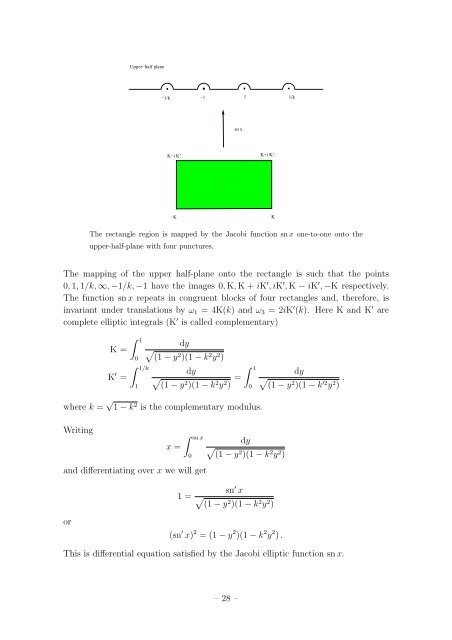Student Seminar: Classical and Quantum Integrable Systems
Student Seminar: Classical and Quantum Integrable Systems
Student Seminar: Classical and Quantum Integrable Systems
Create successful ePaper yourself
Turn your PDF publications into a flip-book with our unique Google optimized e-Paper software.
Upper−half plane<br />
01 01 0 0 1 1 01<br />
−1/k<br />
−1<br />
1<br />
1/k<br />
sn x<br />
K−i K’<br />
K+i K’<br />
+<br />
−K<br />
K<br />
The rectangle region is mapped by the Jacobi function sn x one-to-one onto the<br />
upper-half-plane with four punctures.<br />
The mapping of the upper half-plane onto the rectangle is such that the points<br />
0, 1, 1/k, ∞, −1/k, −1 have the images 0, K, K + iK ′ , iK ′ , K − iK ′ , −K respectively.<br />
The function sn x repeats in congruent blocks of four rectangles <strong>and</strong>, therefore, is<br />
invariant under translations by ω 1 = 4K(k) <strong>and</strong> ω 3 = 2iK ′ (k). Here K <strong>and</strong> K ′ are<br />
complete elliptic integrals (K ′ is called complementary)<br />
K =<br />
K ′ =<br />
∫ 1<br />
0<br />
∫ 1/k<br />
1<br />
dy<br />
√<br />
(1 − y2 )(1 − k 2 y 2 )<br />
∫<br />
dy<br />
1<br />
√<br />
(1 − y2 )(1 − k 2 y 2 ) =<br />
where k = √ 1 − k 2 is the complementary modulus.<br />
Writing<br />
x =<br />
∫ sn x<br />
<strong>and</strong> differentiating over x we will get<br />
0<br />
1 =<br />
dy<br />
√<br />
(1 − y2 )(1 − k 2 y 2 )<br />
sn ′ x<br />
√<br />
(1 − y2 )(1 − k 2 y 2 )<br />
0<br />
dy<br />
√<br />
(1 − y2 )(1 − k ′2 y 2 ) ,<br />
or<br />
(sn ′ x) 2 = (1 − y 2 )(1 − k 2 y 2 ) .<br />
This is differential equation satisfied by the Jacobi elliptic function sn x.<br />
– 28 –

















